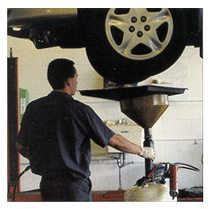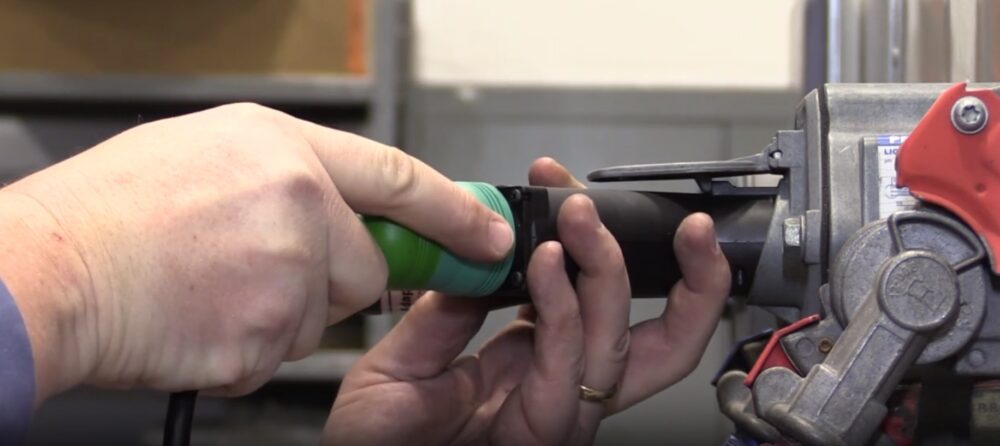Automatic transmission work has always been considered hard, dirty work. And rightly so. Pulling a transmission, especially on a front-wheel-drive car or minivan, can be a long day’s work. It usually involves supporting the engine while the transmission and subframe are dropped from the vehicle. Consequently, you need some type of engine hoist or engine compartment engine support to keep the engine in place, and a hoist to lift the vehicle. But these are not really transmission service tools as such.
 Changing transmission fluid is another dirty job. It’s a more difficult task than changing engine oil because few transmissions have a drain plug or an external fluid filter. Consequently, the lower pan must be removed from the transmission to drain the fluid and replace the filter. This requires a rather sizable catch pan and common hand tools to remove the pan bolts and filter screws.
Changing transmission fluid is another dirty job. It’s a more difficult task than changing engine oil because few transmissions have a drain plug or an external fluid filter. Consequently, the lower pan must be removed from the transmission to drain the fluid and replace the filter. This requires a rather sizable catch pan and common hand tools to remove the pan bolts and filter screws.
For routine scheduled maintenance and changing ATF, a transmission fluid exchange machine is highly recommended. A simple drain and fill can leave up to half or more of the old fluid inside the torque converter. Few torque converters have a drain plug for fluid changes, so the best way to assure a complete fluid change is to use a machine that exchanges new fluid for the old.
ATF exchange machines are quick and easy to use, and the whole process only takes about 10-20 minutes depending on the vehicle. On most vehicles, the fluid is exchanged while the engine is idling with the transmission in Park. But on Mitsubishi vehicles and Chrysler and Hyundai models with Mitsubishi transmissions, oil does not flow to the ATF cooler when the transmission is in Park. You have to put the transmission in Neutral (remember to set the parking brake!). Some fluid exchange/flush machines also allow the use of a cleaner product to remove varnish and sludge from neglected transmissions. If the machine has a pressure gauge, you can use it to detect possible restrictions in the transmission fluid circuit (filter, lines or ATF cooler). Normal pressure readings may be as low as 8 to 10 psi with some vehicles. Readings less than 8 psi may indicate a restriction.
Fluid changes are very important because the Automatic Transmission Rebuilders Association (ATRA) says fluid breakdown is the No. 1 cause of most transmission failures. Worn-out, oxidized transmission fluid can’t provide the same level of lubrication and protection as fresh fluid. Contaminants in the fluid and varnish build up can cause control valves to stick, and bearings and clutches to fail inside the transmission.
Worn-out transmission fluid usually has a burnt smell and a discolored brownish appearance. A “blotter test” can also be used to reveal the fluid’s condition. Place one or two drops of ATF from the transmission on a paper towel and wait about half a minute. If the spot is widely dispersed and red or light brown in color, the fluid is still good. But if the spot does not spread out and is dark in color, the ATF is oxidized and should be changed.
Diagnostic Tools
Special tools are most often needed when diagnosing transmission problems and when overhauling units. In days gone by when transmissions where purely mechanical and hydraulic, all you needed was a set of high pressure gauges to check line pressures. You also needed a vacuum gauge to check the engine’s intake vacuum and the integrity of the vacuum modulator. But with today’s electronic controls, you also need a scan tool and a multimeter.
Transmission codes and sensor data on late-model vehicles is usually accessed through the OBD II diagnostic connector and the Powertrain Control Module (PCM). But on older vehicles with electronic transmissions, the information is often found in a separate Transmission Control Module (TCM) or Body Control Module (BCM). Either way, you’ll need a scan tool to access fault codes and operating data.
An inexpensive code reader or basic scan tool is better than no scan tool at all, but most of these tools can only read “generic” OBD II codes, which don’t include a lot of transmission codes. For serious diagnostic work, you’ll need a professional-grade scan tool with software that can read OEM “enhanced” transmission codes and perform OEM diagnostic tests.
A scan tool can also help you check for communication faults between the PCM and transmission controller if the vehicle has separate computers. Problems here will typically cause the transmission to go into a “limp in” mode that may lock it in 2nd gear.
Some transmission problems may or may not set a fault code and turn on the MIL lamp, so it’s important to always scan the PCM or transmission module for codes if there’s a transmission-related complaint or driveability code. Some engine sensor failures (the throttle position sensor, MAP sensor or vehicle speed sensor, for example, can also affect the operation of the transmission. So it may be necessary to check these sensors as well.
If you find a transmission fault code, you may have to check the resistance of a solenoid in the valve body, or its operating voltage or the frequency of its control signal from the computer. This will require a digital multimeter (DMM) that can read voltage, resistance and frequency or dwell.
You will also need the applicable service information that includes wiring schematics and OEM diagnostic charts with test specifications for all the components that need to be checked. This kind of information can be found in OEM service manuals, on OEM websites (daily one-time access fees are typically $15 to $25), or through online technical information service providers such as ALLDATA, Identifix or Mitchell On-Demand. You should also check for any technical service bulletins (TSBs) that may be related to the transmission problem. In some cases, it may be necessary to reflash (reprogram) the PCM or transmission module to cure a particular fault.
Repair or Replace?
Time is money, so if a transmission is found to have an internal problem or needs to be overhauled, the quickest and easiest fix is to usually replace the transmission with a new or remanufactured unit. Rebuilding transmissions requires a lot of special tools, such as pullers and drivers. It also requires experience and know-how. The risk of a comeback is high if the unit is not rebuilt correctly, so unless you rebuild transmissions full-time for a living, it probably isn’t worth your time or trouble to buy a lot of transmission specialty tools. Every transmission is different and it takes quite an arsenal of special tools to handle even the most popular makes and models. You’re probably better off leaving this kind of work to a transmission specialist or transmission rebuilder.
One tool you should have, though, for replacing transmissions is a transmission jack. Transmissions are very heavy so having a jack that is designed for this purpose can make removal and installation much easier and safer. A transmission jack has arms that support and hold the transmission securely during removal and installation.
For manual transmission work, such as replacing a clutch, you’ll need a pilot tool to align the clutch disk to the pilot bearing or bushing in the flywheel. You’ll also need a straight edge and feeler gauges to check the flatness of the flywheel.
And if the flywheel needs to be resurfaced? You’ll need a flywheel grinder. Grinding machines that spin the flywheel and grind the surface with a rotating cup-shaped stone produce a more accurate surface finish than old-style platten or flat-stone grinders where the flywheel is hand held over a rotating stone. The old-style machines can’t do stepped or recessed flywheels.


